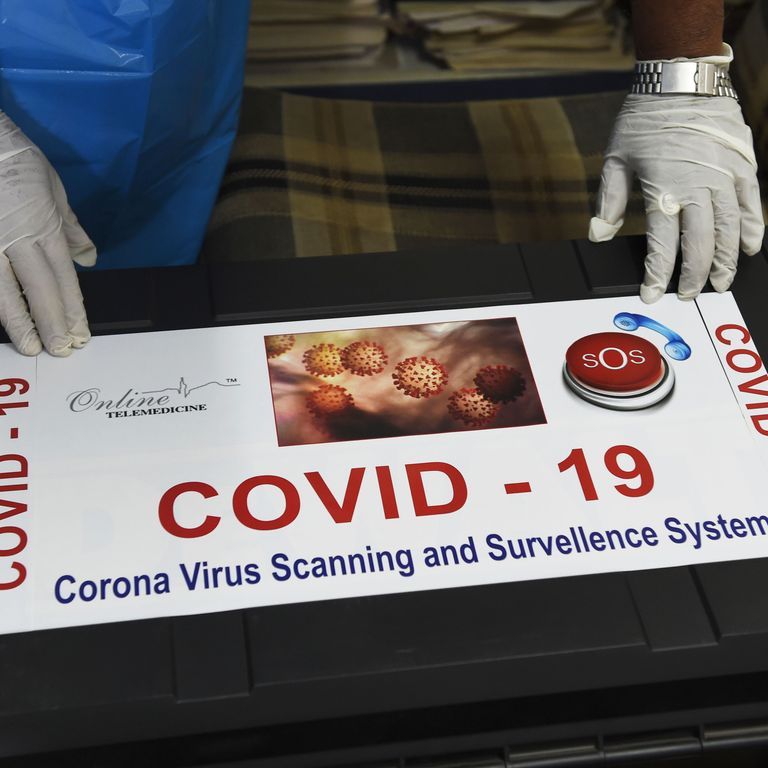- There are estimates of the current mortality rate of novel coronavirus, but no one knows for sure yet what the actual rate is.
- Until more testing is done in people who present mild symptoms or don’t present symptoms at all, it’s impossible to get an accurate death rate for the virus.
- Experts say it’s less important to focus on the mortality rate and more important to focus on how the virus can be deadly for certain populations, like the elderly and immunocompromised.
It’s pretty much impossible to look at your phone or turn on the news right now without hearing about novel coronavirus and the impact it’s having across the country (and world). Currently, there are over 7,000 cases of COVID-19 in the U.S., according to a CDC update on March 18.
Amidst all the news coverage of the pandemic is still a lot of misinformation floating around and a lot of unanswered questions, particularly about exactly how deadly the novel coronavirus illness is.
Here, Natasha S. Hochberg, MD, MPH, associate professor of medicine at Boston University School of Medicine and infectious disease physician at Boston Medical Center, explains what to know about the COVID-19 mortality rate—and why it’s so tough to calculate this statistic.
First: What exactly is novel coronavirus, and when and where did it start?
SARS-CoV2, the virus that causes the illness COVID-19, is a member of the coronavirus family that also contains the viruses that triggered the recent MERS and SARS epidemics, per the World Health Organization (WHO). This particular virus was first detected in humans in December 2019.

SARS-CoV2 is a zoonotic virus, a class of pathogens that are able to be transferred from animals to humans and vice versa, and it’s thought that it first made the jump to humans at a market in Wuhan City, China. This type of transmission is pretty common in the world of viruses, says Dr. Hochberg, noting that the virus is able to transfer to birds, pigs, and humans.
So…exactly how deadly is this illness?
This outbreak is changing rapidly, and if you tried to calculate mortality rates in countries with large-scale outbreaks, not only would you likely not see a consistent figure, that figure is also likely to decrease once scientists are able to more fully grasp the big picture.
When an outbreak begins, it’s those who are the sickest who are more likely to go to the hospital and get diagnosed, notes Dr. Hochberg. If people who weren’t showing symptoms were also being tested for novel coronavirus, for example, the percentage of people who have the virus but recover from it would be much higher—and the mortality rate would be lower, she explains.
For example, early estimates of the mortality rate associated with novel coronavirus in Wuhan, China (where the outbreak began), were around 2 or 3 percent in that specific Chinese population—which may sound alarming, considering that is much higher than the 0.1 percent global fatality rate of the flu. But now that more cases have been detected, the death rate in Wuhan may be closer to 1.4 percent, according to a paper submitted to a journal by a team of infectious disease experts (though it has not yet been peer-reviewed).



In terms of the global impact, WHO officials stated at a news conference last week that “globally, about 3.4 percent of reported COVID-19 cases have died,” according to Reuters. But again, in order to calculate an accurate mortality rate, scientists have to know exactly how many people were infected, and unless we have widespread testing, which is still likely weeks away in the U.S., there’s a chance the true mortality rate won’t be known for a while.
With that in mind, it isn’t super helpful to dwell on the mortality rate. But it is important to take the spread of the virus seriously since it *can* cause death, particularly in high-risk populations. Those who are more at risk for getting very sick from this illness are older adults, those who are immunocompromised, and those with serious chronic medical conditions like heart disease, diabetes, and lung disease. And experts agree that COVID-19 is much more contagious than the flu (one person with COVID-19 can infect two people, according to WHO), and more contagious than SARS (though SARS was more deadly).
Dr. Hochberg says most experts believe that even after the novel coronavirus is contained, this isn’t likely to be the last pandemic the world will see, especially as the world continues to become (metaphorically) smaller, as people often travel quickly and easily from one place to another. “Unfortunately, outbreaks have happened since ancient history and they will continue to happen,” Dr. Hochberg says. “The most critical thing we learn in each outbreak is the importance of international collaboration and sharing of data and resources. A virus anywhere can rapidly become a virus everywhere.”
Remind me again what COVID-19 symptoms I should be on the lookout for?
According to the CDC, there are three major symptoms of COVID-19: fever, cough, and shortness of breath. It can take up to 14 days from contracting the disease for symptoms to start showing. WHO reports that others may experience aches and pains, nasal congestion, runny nose, sore throat, or diarrhea, but for most people, these symptoms will be mild—and some people may be infected and experience no symptoms at all. The only way to truly tell if someone has COVID-19 is by administering a test.
When should people go to the doctor if they suspect they have novel coronavirus?
While only about one in five people who catch COVID-19 will need hospitalization, according to WHO, there are circumstances when checking in with your doctor is a good idea. The organization warns that if you’re having trouble breathing, this may be a sign that you’ve developed a respiratory infection or other serious condition as a result of COVID-19, and you should talk to a health-care provider.
Always call your doctor first before going in for an appointment in order to give the office a heads up,and a chance to take the necessary steps to keep others from being exposed to the virus if you do have it.
How exactly is the novel coronavirus transmitted from person to person?
While research is ongoing, novel coronavirus is thought to be passed from person to person most often via droplet transmission. That means that when an infected individual coughs or sneezes and little virus particles are expelled (and can be spread up to six feet away), they can land on another person, or certain surfaces frequently touched by other people, and later be transferred from that person’s hands to their mouth, nose or eyes, leading to infection.

The CDC guidelines on COVID-19 still state that people are likely most contagious when their symptoms are the worst, but the site also states scientists are continuing to learn more about this disease and new research suggests that people may be contagious before they start experiencing symptoms.
And I should keep doing what I’m doing to protect myself and others from getting sick, right?
You bet. Even as new research continues to deepen scientists’ understandings of this virus, the best thing you can do to protect yourself is to continue to follow the guidelines from organizations like the CDC and WHO. The key to preventing the spread of a respiratory virus like COVID-19 is to protect yourself from exposure to virus droplets, Dr. Hochberg reminds.


She recommends coughing into your elbow, sneezing into a tissue, and washing your hands. “Imagine the world is covered in a layer of viruses and bacteria,” she says. “The best way for you to not become infected is to wash your hands.” It’s also important to avoid touching your face and practice social distancing as much as possible, whether you feel sick or not, since you can spread the virus either way. (Yes, if you’re asymptomatic, you could still have COVID-19 and not know it.)
Remember: While, social distancing can feel disruptive and isolating, it’s the type of behavior change that gives health-care workers the *best* shot at controlling the outbreak and keeping morality rates low.
Source: Read Full Article